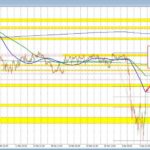
Trump’s Tariff Tactics: The Impact on U.S.-China Trade Relations
Tháng 4 7, 2025
USD/CHF Currency Analysis: Navigating Key Resistance Levels and Market Trends
Tháng 4 7, 2025The Offshore Yuan’s Volatility: Impact of U.S. Tariffs on China’s Currency
The offshore yuan (CNH) has experienced a tumultuous period recently, reflecting a turbulent landscape in international trade. With the recent announcement of aggressive tariffs by U.S. President Donald Trump, the currency has weakened significantly, dipping below the critical level of 7.30 per dollar as of April 7, 2025. This devaluation follows a one-month low reached in offshore trading, primarily driven by global market reactions to Trump’s proposed levies on Chinese and other goods.
New Tariffs and Market Response
President Trump has stirred the economic pot further by introducing a baseline tariff of 10% on all U.S. imports, significantly affecting Chinese products, which are now facing penalties resulting in total tariffs as high as 54%. This escalation has catalyzed a sell-off of the yuan against the dollar, with traders adjusting their expectations in light of the heightened trade tensions. As the yuan opened on the mainland at approximately 7.30 per dollar, analysts warned that the potential for further depreciation looms, especially if the People’s Bank of China (PBOC) fails to intervene.
Moreover, the yuan’s decline to levels not seen since mid-February 2025 illustrates the immediate market sentiments following these tariff announcements. Speculators are now closely watching the PBOC’s moves, as they will be critical in determining whether the yuan can stabilize or if it will descend further against the dollar. For a more detailed view on China’s strategic moves in this trade scenario influenced by U.S. tariffs, refer to this article on China’s strategic responses to U.S.-China trade tensions.
PBOC’s Cautious Approach
The PBOC faces a delicate balancing act amidst this economic turmoil. Analysts from Mizuho Securities indicate that while the central bank might tolerate some moderate weakening of the yuan to mitigate economic shocks, a significant or rapid decline could jeopardize capital market confidence. Hence, the PBOC is expected to manage the currency’s value with utmost caution as trade friction intensifies. Central bank interventions could include monetary policies aimed at strengthening the yuan or implementing stabilization measures to regain market trust.
Broader Economic Implications
The ongoing depreciation of the yuan poses significant risks to China’s economy, which is already grappling with challenges such as stagnant wage growth and deflationary pressures. The renewed weakness of the yuan complicates the Chinese government’s goal to achieve a modest economic growth target of about 5% for 2025. As tariffs imposed by the U.S. diminish external demand for Chinese goods, the potential for economic slowdown heightens.
As the trade war escalates, analysts caution that unless the PBOC takes decisive action to shore up the currency, the repercussions could extend beyond foreign exchange markets, affecting the broader economy, consumer confidence, and investment landscapes. The ongoing tug-of-war between U.S. and Chinese economic policies will continue to shape the yuan’s trajectory, marking a period of uncertainty and adjustment for global markets.
Conclusion
In conclusion, the fluctuations of the offshore yuan are woven intricately into the fabric of U.S.-China trade relations. President Trump’s aggressive tariff strategy has not only influenced the yuan’s value but also has significant economic implications for China. The PBOC’s role in this evolving narrative will be crucial, as it strives to manage currency depreciation without compromising economic stability. Continuous monitoring of both U.S. and Chinese governmental responses will be essential in forecasting the yuan’s performance in the coming months.

